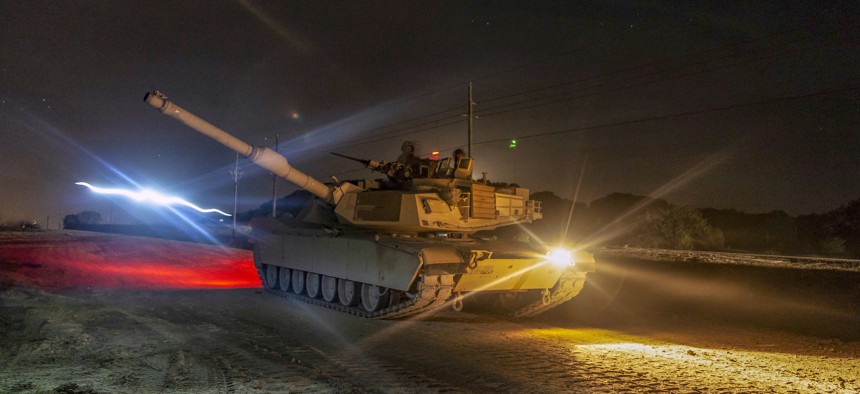
A U.S. Army M1 abrams tank works in unison with tanks from the Polish armed forces during live-fire and maneuvering training in Poland, Nov. 14, 2018, as part of joint training exercise Anakonda. US Army / Sgt. Arturo Guzman
Toward ‘Fort Trump’: US Makes Poland a ‘Serious Robust Offer’
Defense Undersecretary Rood visited Warsaw to negotiate a controversial permanent presence.
U.S. Defense Undersecretary for Policy John Rood met Wednesday in Warsaw with Polish defense officials to negotiate a permanent presence of U.S. forces in the former Soviet satellite, a project long sought by Poland that it has pitched to the U.S. as “Fort Trump.”
Proposals for some kind of U.S. military facility in Poland have been around for decades, and the idea has been a subject of active discussion since Russia invaded Ukraine in 2014. In its most recent defense authorization bill, Congress ordered the Pentagon to issue a report on the possibility. But the idea failed to get any serious traction in Washington — until President Andrzej Duda met with President Trump in September, offering money and naming rights.
“We have come forward with what we think is a very serious robust offer and we're working out some of the technicalities this very week, when we hope to have a solid foundation to work from having coming out of this meeting,” Katie Wheelbarger, Rood’s deputy for international affairs, told the House Armed Services Committee on Wednesday.
The Poles have pushed for a division-sized installation and in September offered to pay $2 billion for a base. Wheelbarger on Wednesday called the offer “very generous” — but some analysts have said it would likely fall far short of the total cost of such a base. Right now, the number of U.S. troops in Poland varies significantly from month to month, but the annual average is about 4,500. They generally belong to two groups: a rotational U.S. brigade near the German border; and a U.S.-led multinational group of 1,000 soldiers near the Suwałki gap, the sole land bridge between Poland at the Baltic countries, seen by some analysts as strategically critical.
Wheelbarger said that if the Polish deputy minister of national defense, Tomasz Szatkowski, accepts Rood’s offer, then the State Department would take over negotiations on the “actual technical agreement.” She suggested that it would take “probably six months to a year” for the agreement to be finalized.
But she offered no details on the specifics of the U.S. offer — including whether it hewed closer to the Polish request for a full division or something smaller and potentially more dispersed. (She also did not comment on whether it calls for a base named after the president.)
One person familiar with the negotiations tempered expectations that any framework agreement reached by Rood and his counterpart in Warsaw would amount to “Fort Trump.”
“This is more of a longer-term commitment to the type of presence that’s already in Poland, this is not a new U.S. base as some people think,” that person told Defense One.
A DoD spokesperson said that the negotiations will remain private until the US and Poland reach a final agreement.
“We continue to work together with Poland and in consultation with NATO Allies to develop a path forward for U.S. troop presence in Poland,” said Eric Pahon.
Although the “Fort Trump” moniker drew sniggers in both Washington and Warsaw, a permanent presence of U.S. forces in Poland is a serious, if controversial, proposal. Proponents of the move argue that it would shore up deterrence against Russia, signal a U.S. commitment to protect NATO’s vulnerable northeastern flank, and pre-position U.S. combat power in the event war did break out with Russia in the region. Critics, meanwhile, argue that it will be costly and will unnecessarily escalate tensions with Russian President Vladimir Putin. Retired Lt. Gen. Ben Hodges, a former commander of U.S. Army Europe, has also argued that it could fracture NATO cohesion if the United States unilaterally puts a permanent base in Poland.
“The reasons the United States has until now avoided building a permanent base in Poland remain in place, including expense, military necessity, vulnerability, and the lack of an armored division available for deployment,” Jim Townsend, deputy assistant secretary of defense for Europe and NATO under President Obama, wrote after Trump’s meeting with Duda.
“It is not easy to find a division to send—it has to come from somewhere, and the congressional delegation from whose state the division might be taken would fight to the last breath to keep it,” he noted.
Gen. Curtis Scaparrotti, Supreme Commander of Allied Forces Europe, said Wednesday that “a mix” of permanent or rotational forces would be ideal in Poland.
“I am perfectly content with the large forces that are rotating today. I get a ready force, I send it home ready,” he told the House panel. “Some of the enablers, et cetera, some of the headquarters—a more permanent base is helpful because of the relationships you build and the mission they have. So you'll see a little bit of a combination there from my point of view.”





